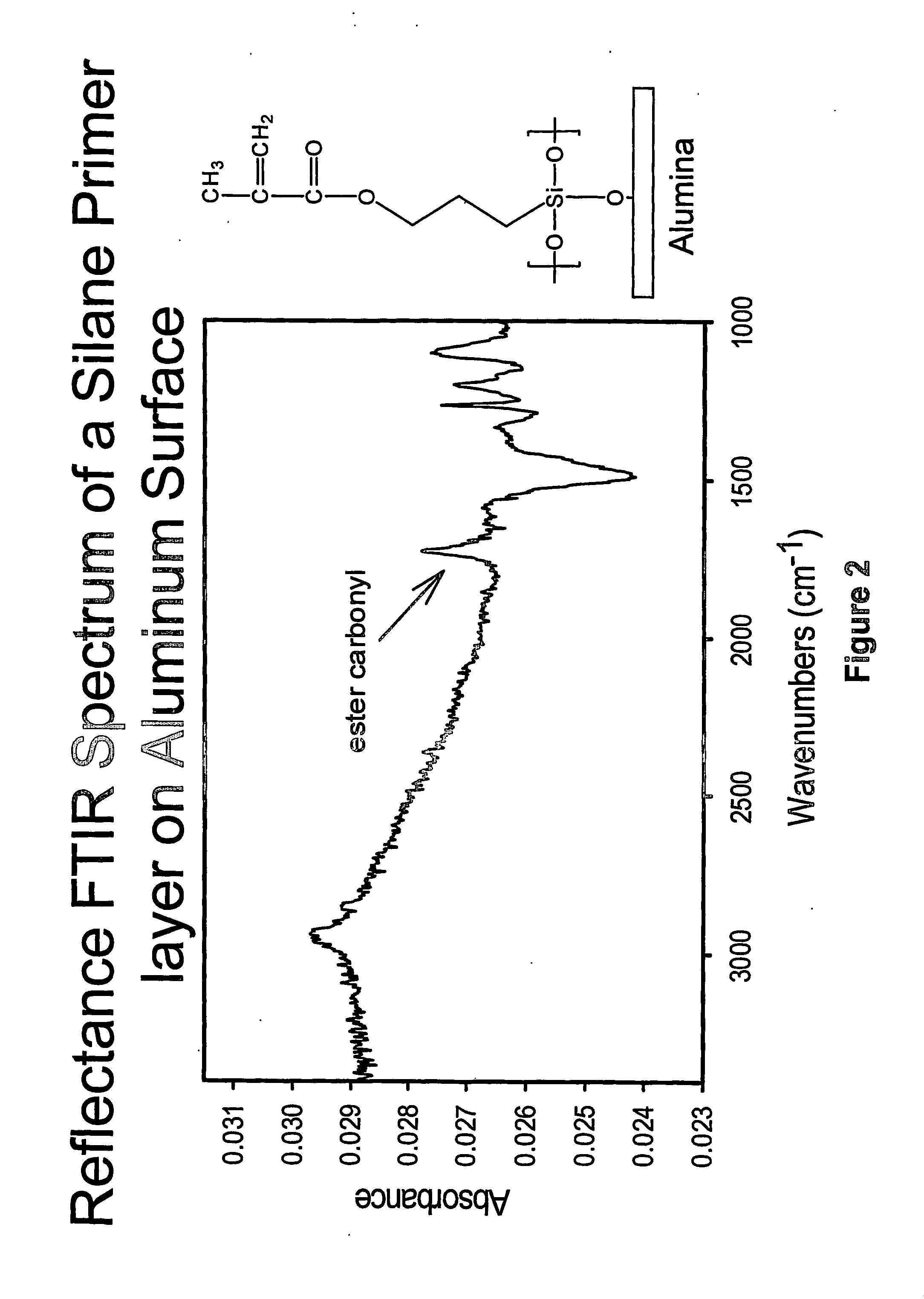Photocrosslinked hydrogel surface coatings
a surface coating and photocrosslinked technology, applied in the field of photocrosslinked hydrogel surface coatings, can solve the problems of insufficient mass-spectral utilization of hydrogel potential, inability to prepare polymers, and conventional procedures for producing hydrogels that typically do not provide coating uniformity and homogeneity, etc., to achieve the effect of increasing binding capacity, reducing the amount of surface area, and fast cure times
- Summary
- Abstract
- Description
- Claims
- Application Information
AI Technical Summary
Benefits of technology
Problems solved by technology
Method used
Image
Examples
example 1
Preparation of Copolymers of Sax Monomer and Photocrosslinkable Monomer
[0241] SAX copolymers having 3 mol. %, 5 mol. %, 7 mol. %, and 10 mol. % of photocrosslinkable groups were prepared. The concentration of photocrosslinkable groups along the polymer backbone was varied in an attempt to study its effect on the stability of surface hydrogel coatings and on the protein adsorption, and provide hydrogel materials with various degrees of crosslinking.
[0242] A photocrosslinkable copolymer having 10 mol. % photocrosslinkable group was prepared. More particularly, with reference to FIG. 1 below, 22 grams of 3-(methacryloylamino)propyl-trimethylammonium chloride solution (Aldrich, 50 wt. % in water) were mixed with 30 grams of distilled water, followed with 2.32 grams of 2-(acryloyloxy)ethyl](4-benzoylbenzyl) dimethylammonium bromide (Aldrich), 0.045 grams of V-50 (Wako Chemical), a water-soluble, cationic azo-initiator. The solution was purged with a flow of argon for five minutes. The ...
example 2
Preparation of a Prime Silane Layer on Bare Aluminum Surface by Chemical Vapor Deposition (CVD) Process
[0244] Aluminum substrates were chemically cleaned with 0.01N HCl and methanol in an ultrasonic bath for 40 min, respectively. After wet cleaning, aluminum substrates were further cleaned with UV / ozone cleaner for 30 min. In the following CVD silanation process, the aluminum substrates were placed in a reaction chamber along with 3-(trimethoxysilyl) propyl methacrylate (Aldrich). A vacuum was pulled on the chamber, and the silane vaporized and reacted with the surface. The reaction was kept for 48-h for completion.
[0245] The formation of methacrylate-coated silane layers on the surface was confirmed with surface reflectance FTIR (FIG. 2) and contact angle measurements.
[0246] In another example of producing a primer silane layer by CVD process, octadecyltrichlorosilane (Aldrich) was used to replace 3-(trimethoxysilyl) propylmethacrylate to produce a hydrophobic silane layer on th...
example 3
Preparation of SAX Surface Hydrogel Coatings on SiO2-Coated Aluminum Substrates
[0247] A 10 wt. % aqueous solution of SAX copolymers having 3 mol. %, 5 mol. %, 7 mol. %, and 10 mol. % of photocrosslinkable groups along the polymer backbone were dispensed on the surface of methacrylate-coated aluminum substrates, respectively. The substrates then were subjected to a process of spin-coating at 3,000 RPM for one minute. The polymer-coated chips then were exposed for 20 minutes to UV light of approximately 360 nm in wavelength (Hg short arc Lamp, 20 mW / cm2 at 365 nm). Reflectance FTIR spectra (see FIG. 3) confirmed the formation of SAX hydrogel coating on the surface of aluminum substrates.
[0248] To check the stability of SAX hydrogel coatings on the surface of aluminum substrates, SAX polymeric hydrogel-coated chips were immersed in DI water for 24 h, and surface reflectance FTIR was used to follow this experiment. FTIR spectra showed, in all the cases, that there was no decrease in I...
PUM
| Property | Measurement | Unit |
|---|---|---|
| Thickness | aaaaa | aaaaa |
| Thickness | aaaaa | aaaaa |
| Thickness | aaaaa | aaaaa |
Abstract
Description
Claims
Application Information
 Login to View More
Login to View More - R&D
- Intellectual Property
- Life Sciences
- Materials
- Tech Scout
- Unparalleled Data Quality
- Higher Quality Content
- 60% Fewer Hallucinations
Browse by: Latest US Patents, China's latest patents, Technical Efficacy Thesaurus, Application Domain, Technology Topic, Popular Technical Reports.
© 2025 PatSnap. All rights reserved.Legal|Privacy policy|Modern Slavery Act Transparency Statement|Sitemap|About US| Contact US: help@patsnap.com



